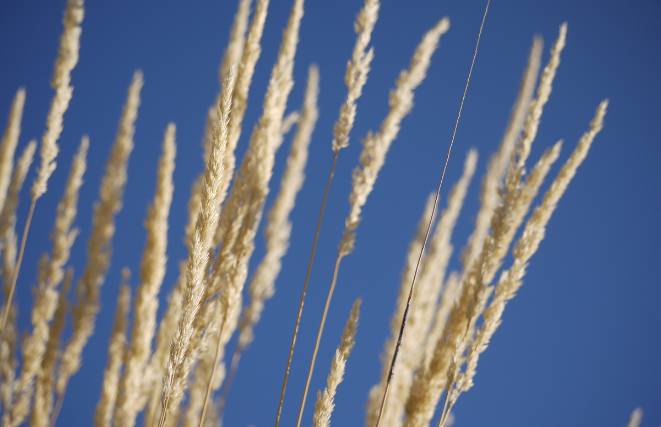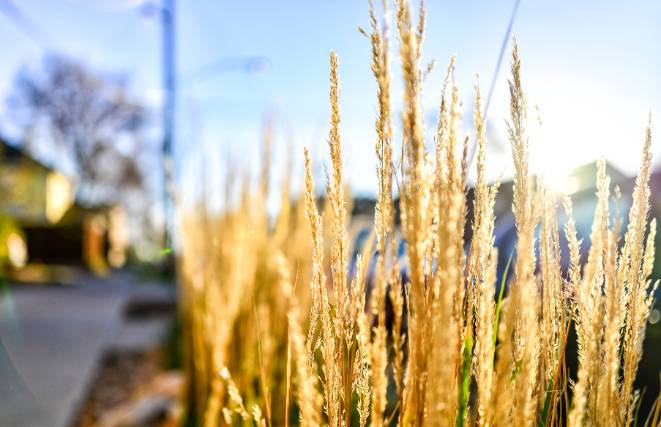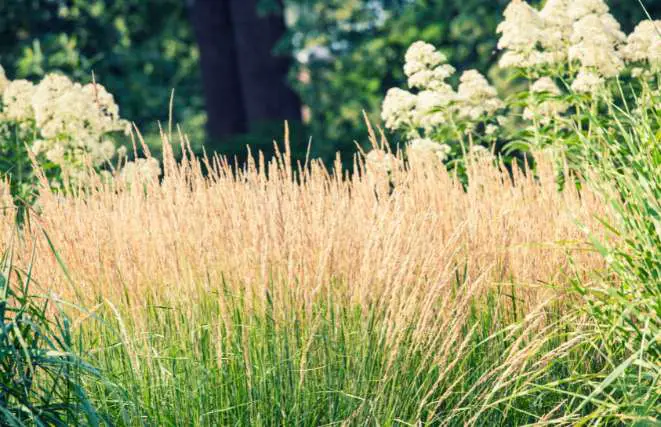In the enchanting world of gardening and landscaping, feather reed grass stands as a beacon of elegance and versatility. With its graceful plumes and hardy disposition, it’s a favorite among both beginner gardeners and seasoned landscape designers. If you’re yearning to add a touch of natural beauty to your outdoor space, you’re in the right place.
In this comprehensive guide, we’ll delve deep into the art of planting and nurturing feather reed grass. From selecting the perfect spot in your garden to addressing potential pests, you’ll emerge with the expertise needed to cultivate this botanical marvel. So, grab your gardening gloves and let’s embark on this green journey together.
Feather Reed Grass Overview
| Factor | Feather Reed Grass |
|---|---|
| Family (Botanic) | Poaceae |
| Other Common Names | Feather Reed Grass, Reed Grass |
| Scientific Name | Calamagrostis acutiflora |
| Height & Spread | 3-5 feet tall, 2-3 feet wide |
| Sun Exposure | Full sun to partial shade |
| USDA Growing Zones | 4-9 |
| Water | Moderate to regular |
| Soil Type | Well-draining, loamy soil |
| Soil pH | Neutral to slightly acidic (6.0-7.5) |
| Bloom Time | Late spring to early summer |
| Flower Color | Purple to beige |
| Native Area | Europe and Asia |
Where to Plant Feather Reed Grass
Feather reed grass, scientifically known as Calamagrostis acutiflora, is a versatile ornamental grass that thrives in various conditions. However, to ensure its optimal growth and aesthetic appeal, choosing the right spot in your garden is essential.
Sunlight Requirements
Feather reed grass is a sun-loving plant, so aim for a location that receives at least 6 to 8 hours of sunlight daily. Partial shade can be tolerated but may result in less vigorous growth and fewer blooms. When selecting the perfect spot, take into consideration the movement of the sun throughout the day, as some areas may receive more sunlight during certain times.
Soil Quality
Well-draining soil is key to keeping your grass healthy. Feather reed grass isn’t picky about soil type, but it detests waterlogged roots. Amending your soil with organic matter can help improve drainage. If you’re uncertain about your soil’s drainage, consider conducting a simple percolation test by digging a small hole and filling it with water. If it takes more than a few hours for the water to drain completely, you may need to address drainage issues.
Space Consideration
Ensure you give your feather reed grass enough room to spread its graceful blades. Typically, spacing them 2 to 3 feet apart should suffice. However, if you plan to incorporate multiple plants, take into account their mature size and growth habit. Providing ample space between plants allows for better air circulation, reducing the risk of disease and ensuring each plant has room to flourish.
Complementary Planting
Consider the surrounding plants and design when choosing the location for your feather reed grass. Its upright, elegant growth can serve as a stunning backdrop for shorter flowering plants or as a striking focal point in your garden. Plan your garden layout to highlight the unique beauty of this grass and create a harmonious visual composition.
How and When to Plant Feather Reed Grass
Now that you’ve identified the perfect location, it’s time to get your hands dirty and embark on your feather reed grass gardening journey. Feather reed grass can be planted from either seeds or nursery-grown plants. Here’s a step-by-step guide:
Select Your Plants
If you’re going the nursery route, choose healthy, disease-free specimens. Look for vibrant green foliage and strong root systems. Healthy nursery plants are the foundation of a thriving feather reed grass garden. Take your time to inspect each plant’s overall condition, paying attention to the leaves, stems, and root structure. Avoid any specimens with signs of disease or stress.
Timing Matters
The best time to plant feather reed grass is in the spring or early fall. This timing allows the roots to establish before the harsh heat of summer or the cold of winter sets in. Spring planting takes advantage of the favorable growing conditions and the plant’s natural growth cycle, while fall planting allows the grass to establish its roots before winter dormancy.
Prepare the Soil
Dig a hole that’s twice the width of the root ball and of the same depth. Loosen the soil at the bottom and mix in compost or well-rotted organic matter. Proper soil preparation is crucial for providing your feather reed grass with the nutrients and structure it needs to grow strong and healthy. The addition of organic matter not only enriches the soil but also enhances its ability to retain moisture and nutrients.
Planting Depth
Place the grass in the hole, making sure the crown (where the stems meet the roots) is level with the soil surface. Backfill and gently tamp down the soil. Planting at the correct depth ensures that the roots receive adequate oxygen and that the crown is protected from potential rot. Be mindful not to bury the crown too deeply, as this can lead to issues like rot and poor growth.
Watering
Water thoroughly after planting to settle the soil and eliminate air pockets. Keep the soil consistently moist during the first growing season. Adequate watering is crucial during the initial establishment phase. Watering immediately after planting helps remove air gaps around the roots and ensures good soil-to-root contact. Throughout the first year, monitor soil moisture to prevent drying out, which can stress the plant.
Mulch for Moisture
Apply a layer of mulch around the base of the grass to help retain moisture and prevent weed growth. Mulch serves multiple purposes, including conserving soil moisture, regulating soil temperature, and suppressing weed growth. It also adds a polished look to your garden and reduces the need for frequent weeding.

How to Grow Feather Reed Grass
Congratulations! You’ve successfully planted your feather reed grass. Now, let’s discuss how to ensure it thrives.
Regular Watering
Feather reed grass prefers consistent moisture but can tolerate drought once established. Water deeply when the top inch of soil feels dry. To maintain optimal moisture levels, consider installing a soaker hose or drip irrigation system. These methods deliver water directly to the roots, minimizing water loss to evaporation and keeping your grass content.
Fertilize Sparingly
Excessive fertilization can lead to floppy growth. Apply a balanced, slow-release fertilizer in the spring, sparingly. Over-fertilizing can result in overly lush growth, which may lead to flopping or lodging of the grass, diminishing its ornamental value. Opt for a balanced, slow-release fertilizer to provide the necessary nutrients without overstimulating growth.
Pruning
In late winter or early spring, before new growth emerges, trim the grass to about 6 inches above the ground. This rejuvenates the plant and promotes healthy growth. Pruning is essential for maintaining the overall health and appearance of your feather reed grass. It helps remove dead or damaged growth, encourages fresh growth, and prevents the grass from becoming overly leggy. Ensure your pruning tools are sharp to make clean cuts without tearing the grass blades.
Dividing
Every few years, consider dividing your grass to maintain its vigor. Spring or fall is the best time for this task. Division is a natural part of feather reed grass care, as it prevents overcrowding and reinvigorates established clumps. Carefully dig up the entire plant and divide it into smaller sections, each with a portion of roots and shoots. Replant these divisions in suitable locations in your garden, or share them with fellow gardening enthusiasts to spread the beauty of feather reed grass.
How to Care for Feather Reed Grass
While feather reed grass is relatively low-maintenance, a little care goes a long way in maintaining its beauty.
Weeding
Keep the area around your grass clear of weeds to prevent competition for nutrients and water. Regular weeding not only enhances the aesthetics of your garden but also ensures that your feather reed grass gets the nutrients and moisture it needs to thrive.
Pest Vigilance
Feather reed grass is generally pest-resistant. However, keep an eye out for aphids and grasshoppers, especially during dry spells. These pests can occasionally target your grass, potentially affecting its growth. A keen eye and early intervention with organic insecticides when necessary can help you maintain a pest-free garden.
Winter Protection
In areas with harsh winters, consider leaving the dried foliage in place to provide insulation for the roots. Prune in early spring. Feather reed grass can withstand cold temperatures well, but some additional protection during winter can be beneficial. Leaving the dried foliage intact during the winter months can act as a natural blanket, shielding the roots from extreme cold.
Pests and Problems with Feather Reed Grass
While feather reed grass, known scientifically as Calamagrostis acutiflora, is generally hardy and resilient, it can encounter a few challenges along its growth journey. Being aware of potential issues and knowing how to address them will help you maintain the health and beauty of your feather reed grass. Here are some common problems and solutions:
- Pests: As mentioned, aphids and grasshoppers can be occasional nuisances. Use organic insecticides sparingly if needed.
- Fungal Diseases: Root rot and rust are possible concerns in damp conditions. Ensure proper drainage and good air circulation.
- Fertilizer Overload: Avoid over-fertilizing, which can result in weak, floppy growth. Stick to a light feeding regimen.
How to Propagate Feather Reed Grass
If you’re captivated by the elegance of feather reed grass and wish to expand its presence in your garden or share its beauty with fellow gardening enthusiasts, propagation is the way to go. Here are two reliable methods for propagating feather reed grass:
Division
As mentioned earlier, dividing mature plants every few years is a reliable method. Dig up the plant and separate the root clumps into smaller sections, each with roots and shoots. Replant them in suitable locations.
Seed Sowing
Collect seeds from your grass in late summer or early fall and sow them in a seed tray. Keep them indoors until they sprout, then transplant them into your garden.
Types of Feather Reed Grass
Feather reed grass, or Calamagrostis acutiflora, presents garden enthusiasts with a delightful array of cultivars, each possessing its unique charm and characteristics. These variations in color, height, and growth habit offer garden designers and amateur horticulturists alike an opportunity to create diverse and visually captivating landscapes. Here are a few noteworthy types of feather reed grass:
- ‘Karl Foerster’ (Calamagrostis acutiflora ‘Karl Foerster’): Renowned for its elegant, vertical growth habit and feathery plumes, ‘Karl Foerster’ is a staple in many gardens. Its narrow, upright form makes it an excellent choice for creating a sense of height and movement in your landscape design.
- ‘Overdam’ (Calamagrostis acutiflora ‘Overdam’): If you’re seeking a touch of contrast and a dash of flair, ‘Overdam’ delivers with its variegated foliage. The blades feature striking white stripes that accentuate the green, adding visual interest and a touch of brightness to your garden.
- ‘Avalanche’ (Calamagrostis acutiflora ‘Avalanche’): This cultivar stands out with its compact size and captivating variegated leaves. Featuring green edges and white centers, ‘Avalanche’ lends a unique charm to borders and containers, offering an eye-catching focal point for your garden.
- ‘Stricta’ (Calamagrostis acutiflora ‘Stricta’): If you desire a more compact feather reed grass, ‘Stricta’ fits the bill. It forms a dense, narrow clump with elegant green foliage and striking feathery plumes that sway gracefully in the breeze.
- ‘Eldorado’ (Calamagrostis acutiflora ‘Eldorado’): For a touch of golden radiance in your garden, ‘Eldorado’ is a splendid choice. Its bright yellow foliage adds a burst of color, especially during the growing season, making it a fantastic companion plant for other ornamental grasses or perennials.
- ‘Karl Foerster’ Dwarf (Calamagrostis acutiflora ‘Karl Foerster’ Dwarf): This compact version of the classic ‘Karl Foerster’ maintains the same vertical elegance but on a smaller scale, making it suitable for smaller gardens or container gardening.

Does Feather Reed Grass Spread?
Feather reed grass (Calamagrostis acutiflora) typically forms clumps rather than aggressively spreading like some other grasses. It has a bunching growth habit, meaning it tends to grow in tight, upright clumps or tufts. This clumping nature is one of the reasons why feather reed grass is a popular choice for gardeners and landscape designers.
However, over time, as the grass matures and continues to grow, it may naturally increase in size by producing new shoots and expanding the width of the clump. This gentle expansion can give the appearance of spreading, but it’s not invasive or aggressive.
In summary, feather reed grass does spread gradually by forming clumps, but it is not considered invasive or aggressive in its growth habit. It’s a manageable and well-behaved tall ornamental grass that adds beauty and elegance to gardens and landscapes.
Do You Cut Back Feather Reed Grass in the Fall?
Yes, it’s advisable to cut back feather reed grass in the fall or late winter to early spring. This practice serves multiple purposes, including removing old, unsightly foliage, stimulating new growth, and preventing the grass from flopping over as it grows. The best time for pruning is late winter to early spring, just before new growth begins. Trim the grass to a height of about 6 inches above the ground, dispose of the cuttings, and water the plant to encourage healthy regrowth. This maintenance routine helps maintain the grass’s elegance and prepares it for a new growing season.
What does feather reed grass look like?
Feather reed grass (Calamagrostis acutiflora) is a graceful and ornamental grass known for its elegant appearance. It typically grows in upright clumps, with slender, arching leaves that are bright green and can reach a height of 3 to 5 feet (approximately 90 cm to 1.5 meters). In late spring to early summer, it produces tall, feathery flower plumes that rise above the foliage, adding a sense of movement and texture to the garden. These plumes can range in color from purple to beige, depending on the specific cultivar. As fall approaches, the foliage turns golden-yellow, adding a touch of autumnal beauty to the landscape. Overall, feather reed grass presents a stunning display of vertical elegance, making it a popular choice for gardens and landscapes.
Will feather reed grass grow in shade?
Feather reed grass (Calamagrostis x acutiflora), like many ornamental grasses, prefers full sun to partial shade. While it can tolerate some shade, it typically thrives in locations with at least 6 hours of direct sunlight per day. In partial shade conditions, feather reed grass may not grow as vigorously and might have a more open or upright growth habit compared to plants grown in full sun.
If you’re considering planting feather reed grass in a partially shaded area, make sure it still receives some direct sunlight during the day. In situations where the shade is too dense or prolonged, it may be less suitable, and you might want to explore other ornamental grass options that are better suited for shaded conditions.
FAQ
No, feather reed grass is not evergreen. It is a deciduous grass, which means it sheds its foliage in the fall. As the colder months approach, the grass’s leaves turn brown and dry, making it appear dormant during the winter. However, in late winter to early spring, it begins to produce fresh new growth, and the old, dead foliage can be pruned to encourage this process. Feather reed grass is appreciated for its ability to maintain an attractive appearance throughout the growing season while offering the benefits of seasonal change and renewal in the garden.
Feather reed grass typically grows to a height of 3 to 5 feet (approximately 0.9 to 1.5 meters) and spreads to form clumps with a width of about 2 to 3 feet (approximately 0.6 to 0.9 meters). The size of feather reed grass can vary depending on factors such as the specific cultivar, local growing conditions, and care practices. Some cultivars may be more compact, while others may reach the higher end of the height range. It’s essential to consider the mature size of the specific cultivar you choose when planning its placement in your garden to ensure it has enough space to thrive without overcrowding.
No, feather reed grass is generally not considered invasive. Unlike some other ornamental grasses that have invasive tendencies, feather reed grass has a clumping growth habit, meaning it forms dense, upright clumps rather than spreading aggressively by runners or seeds. While it can gradually increase in size over time by producing new shoots, it does so in a well-behaved manner and is unlikely to take over your garden.
Conclusion
Feather reed grass is more than just a plant; it’s a testament to nature’s artistry. Whether you’re a novice gardener or a landscape designer, its allure and versatility make it a must-have for your outdoor space. From selecting the perfect spot to nurturing its growth and addressing challenges, you now possess the knowledge to cultivate this botanical gem.
As you embark on your journey with feather reed grass, remember that gardening is not just about nurturing plants; it’s about nurturing your connection with the natural world. So, go forth and let the gentle rustle of feather reed grass in your garden be your symphony of serenity. Happy gardening!








